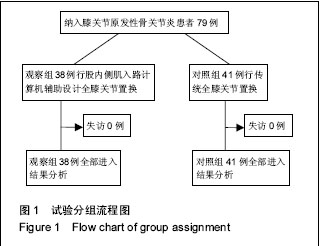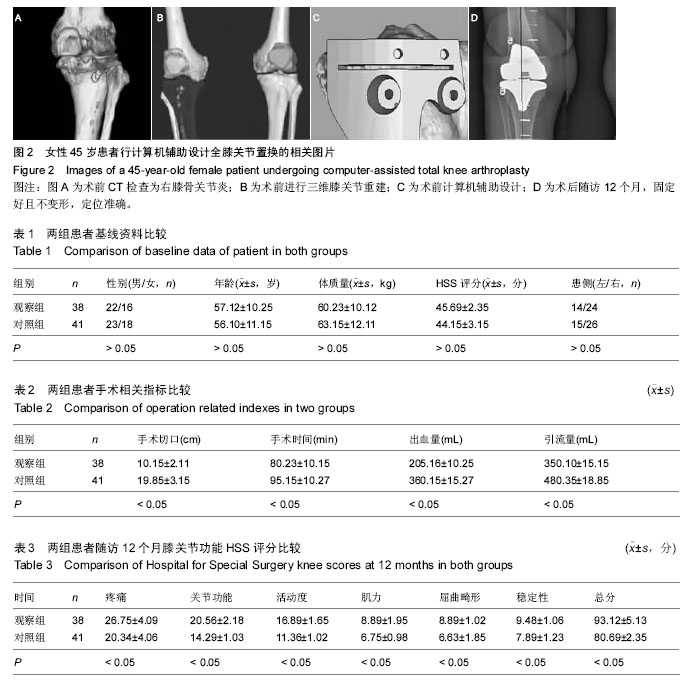| [1] 张淼,白波,陈艺,等.全膝置换术经小切口股内侧肌入路与标准髌旁入路临床疗效比较的 META 分析[J].中华关节外科杂志(电子版),2014,8(3):358-366.
[2] 徐应龙,赵劲民,李书振,等.全膝关节置换术股内侧肌入路与内侧髌旁入路比较的系统评价[J].中国循证医学杂志, 2010,10(5):585-591.
[3] 徐应龙.全膝关节置换术经股内侧肌入路与内侧髌旁入路比较置入假体的系统评价[D].广西医科大学,2010.
[4] 付勇,吴子祥,韩一生,等.Laptop Stryker手术导航仪辅助下人工全膝关节置换术在市级医院的应用[J].泸州医学院学报,2013,36(4):384-386.
[5] 余正红,蔡胥,李鉴轶,等.膝关节血供三维可视化研究及其临床意义[J].中华关节外科杂志(电子版),2007,1(4): 227-231.
[6] Brinkman JM, Bubra PS, Walker P, et al. Midterm results using a medial pivot total knee replacement compared with the Australian National Joint Replacement Registry data. ANZ J Surg. 2014;84(3):172-176.
[7] Brandon SC, Miller RH, Thelen DG, et al. Selective lateral muscle activation in moderate medial knee osteoarthritis subjects does not unload medial knee condyle. J Biomech. 2014;47(6):1409-1415.
[8] Hussain SM, Wang Y, Muller DC, et al. Association between index-to-ring finger length ratio and risk of severe knee and hip osteoarthritis requiring total joint replacement. Rheumatology. 2014;53(7):1200-1207.
[9] Wang L, Vieira RL, Rybak LD, et al. Relationship between knee alignment and T1ρ values of articular cartilage and menisci in patients with knee osteoarthritis. Eur J Radiol. 2013;82(11):1946-1952.
[10] 张树栋,刘克贵,王诗军,等.计算机辅助技术和传统工具下全膝关节置换术后髌骨位置放射学比较[C].//第一届全国计算机辅助外科学术会议论文集,2008:30-31.
[11] Karachalios T,Giotikas D,Roidis N, et al.Total knee replacement performed with either a mini-midvastus or a standard approach: a prospective randomised clinical and radiological trial. J Bone Joint Surg. 2008; 90/A(5): 584-591.
[12] 高英健,王伟力.微创膝关节置换的临床应用现状[J].中国组织工程研究,2013,17(39):6985-6990.
[13] 赵喜滨,李斌,王浩,等.导航技术与传统方法膝关节置换后力线测量的Meta分析[J].实用骨科杂志,2010,16(12): 897-902.
[14] 杜辉,张纪,唐浩,等.计算机辅助导航人工膝关节置换手术的效果观察[J].山东医药,2014,54(36):74-76,77.
[15] Dempsey KE, Collins JE, Ghazinouri R, et al. Associations between preoperative functional status and functional outcomes of total joint replacement in the Dominican Republic.Rheumatology. 2013;52(10):1802-1808.
[16] Nutton RW,van der Linden ML,Rowe PJ, et al.A prospective randomised double-blind study of functional outcome and range of flexion following total knee replacement with the NexGen standard and high flexion components. J Bone Joint Surg. 2008;90/B(12):37-42.
[17] Nutton RW,van der Linden ML,Rowe PJ,et al.A prospective randomised double-blind study of functional outcome and range of flexion following total knee replacement with the NexGen standard and high flexion components. J Bone Joint Surg. 2008;90/A(1):37-42.
[18] 李斌,瓦热斯江-尼亚孜,赵喜滨,等.计算机导航治疗与传统方法进行膝关节置换手术效果比较的系统评价[J].中国循证医学杂志,2010,10(11):1259-1268.
[19] 许伟华,杨述华,陈东,等.计算机导航辅助下和传统人工膝关节置换术后下肢力线和假体位置的比较[C].//全国骨关节与风湿病暨第三届武汉国际骨科高峰论坛论文集,2012:54-56.
[20] 吴昊.计算机辅助人工膝关节置换手术系统简介[J].国外医学:骨科学分册,2005,26(3):137-140.
[21] Hamel MB, Toth M, Legedza A, et al.Joint replacement surgery in elderly patients with severe osteoarthritis of the hip or knee: decision making, postoperative recovery, and clinical outcomes. Arch Int Med. 2008;168(13): 1430-1440.
[22] Chang AH, Lee SJ, Zhao H, et al. Impaired varus-valgus proprioception and neuromuscular stabilization in medial knee osteoarthritis. J Biomech. 2014;47(2):360-366.
[23] Loughnan TE, Taverner MG, Webb A, et al. Randomized, Double Blinded Comparative Trial ofIntradermal Injections of Lignocaine Versus N-SalineAround the Knee to Relieve Pain in Patients AwaitingTotal Knee Replacement. Clin J Pain. 2009;25(4):269-272.
[24] Gillam MH, Lie SA, Salter A, et al. The progression of end-stage osteoarthritis: Analysis of data from the Australian and Norwegian joint replacement registries using a multi-state model. Osteoarthritis Cartilage. 2013;21(3):405-412.
[25] 许伟华,杨述华,陈东,等.计算机导航辅助下和传统人工膝关节置换术后下肢力线和假体位置的比较[C].//第21届中国康协肢残康复学术年会暨第二届“泰山杯”全国骨科青年科技创新论坛论文集,2012:174.
[26] 吴昊,Van Driessche St(e)phane, Daniel Goutallier,等.三维骨建模系统在人工全膝关置换中的优化用用:导肮与规手术早期疗效比较[J].中国组织工程研究与临床康复, 2008,12(13):2564-2568.
[27] 李斌,瓦力斯,王浩,等.计算机导航技术比较传统方法进行膝关节置换术后力线测量的系统评价[C].//第七届西部骨科论坛暨青海省骨科年会论文集,2011:78-78.
[28] Singh JA, Lewallen DG. Cerebrovascular disease is associated with outcomes after total knee arthroplasty: A us total joint registry study. J Arthroplasty. 2014;29(1): 40-43.
[29] Wallis JA, Taylor NF. Pre-operative interventions (non-surgical and non-pharmacological) for patients with hip or knee osteoarthritis awaiting joint replacement surgery-a systematic review and meta-analysis. Osteoarthritis Cartilage. 2011;19(12):1381-1395.
[30] Lundberg HJ, Foucher KC, Andriacchi TP, et al. Direct comparison of measured and calculated total knee replacement force envelopes during walking in the presence of normal and abnormal gait patterns. J Biomech. 2012;45(6):990-996.
[31] 李桓毅,刘方刚,陈建明,等.计算机导航下全膝关节置换截骨的精确度比较[C].//第十一届全军骨科学术大会论文集, 2010:430-431.
[32] 吴昊,Van Driessche Stéphane, Goutallier Daniel, 等.三维骨建模系统在人工全膝关节置换旋转对位中的作[J].中国组织工程研究与临床康复,2009,13(35):6987-6990.
[33] Matsumoto T,Kuroda R,Kubo S,et al.The intra-operative joint gap in cruciate-retaining compared with posterior-stabilised total knee replacement. J Bone Joint Surg. 2009;91/B(4):475-480.
[34] Gooch K, Marshall DA, Faris PD, et al. Comparative effectiveness of alternative clinical pathways for primary hip and knee joint replacement patients: A pragmatic randomized, controlled trial.Osteoarthritis Cartilage. 2012;20(10):1086-1094.
[35] 裴福兴,李程,杨静,等.计算机导航全膝关节置换系统的初步临床应用[C].//第2届中国重庆关节外科国际学术研讨会暨第二届全军关节镜学术研讨会论文集, 2005: 163-166.
[36] Liu YH,Wang TM, Wei IP, et al.Effects of bilateral medial knee osteoarthritis on intra- and inter-limb contributions to body support during gait. J Biomech. 2014;47(2): 445-450.
[37] Alghadir A, Omar MT, Al-Askar AB, et al.Effect of low-level laser therapy in patients with chronic knee osteoarthritis: A single-blinded randomized clinical study.Lasers Med Sci. 2014;29(2):749-755.
[38] 《中国组织工程研究与临床康复》杂志社学术部.人工膝关节临床应用中的假体设计、生物力学性能、计算机辅助技术及其相关争议[J].中国组织工程研究与临床康复, 2010,14(9):1658-1660.
[39] 严志强,张乐,王新亮,等.计算机辅助设计兔解剖型人工膝关节假体[J].广东医学,2014,35(13):1997-2001.
[40] 石更强.基于逆向工程个性化三维仿生膝关节股骨和胫骨部分的精确建模[J].中国组织工程研究与临床康复, 2008,12(35):6831-6834. |
.jpg)


.jpg)
.jpg)